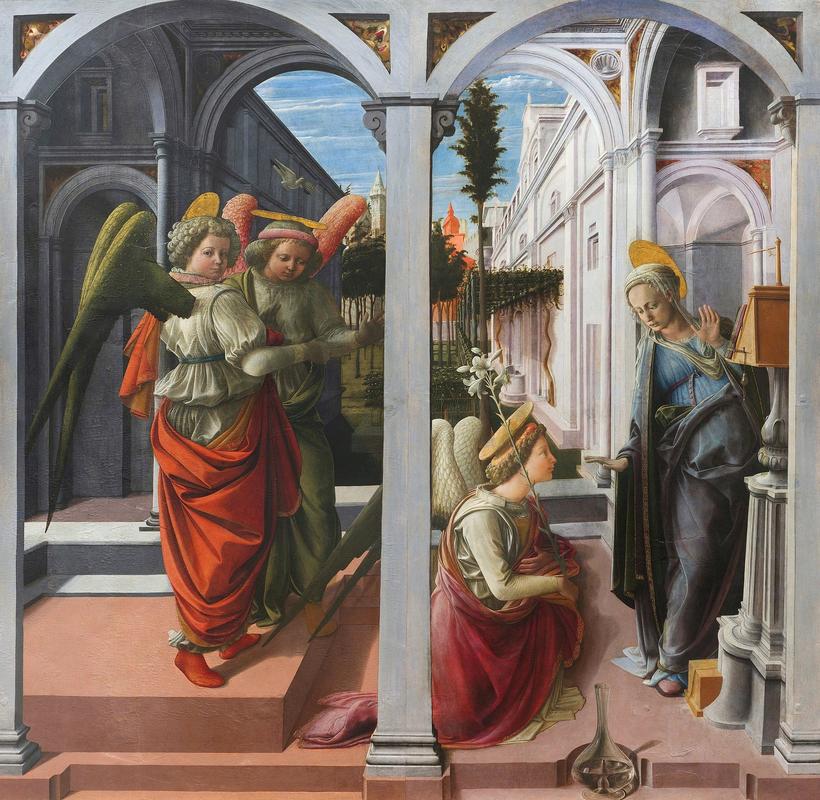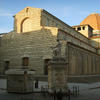More about Annunciation

Contributor
The Friends of Florence group retained the services of Lucia Biondi and Roberto Buda to bring new life to Lippi's Martelli Annunciation in the Martelli Chapel of the Basilica of San Lorenzo.
The 18 months long restoration was scientifically supervised by Monica Bietti. 100-year old restorations by Fabrizio Lucarini, from just before the First World War, were looking worn, which is funny given that the painting had stood for several centuries before Lucarini came along. But Lucarini's protective varnish was turning yellow. Biondi saw that the fire and hot wax of devotional candles had created gaps in the paint, which she filled in. Now, in a real sense, the painting is her work, as much as it is Lippi's, Buda's, Bietti's, Lucarini's, or the many worshippers who have accidentally, in their meditative moments of ecstasy, dropped wax on it.
Leon Battista Alberti's studies on perspective had allowed artists to make compositions look much more accurate, and this is one of the first works reflecting an awareness of Alberti's insights. The architect of the tabernacle frame, Filippo Brunelleschi, paved the way for Instagram by making the composition a neat square, which makes the painting stand out among its contemporaries. The document dictating the format of the work insists on tabula quadrata et sine civoriis, picta honorabiliter: no fancy, high-flung Gothic pinnacles, and keep it square.
The painting is a real Forensic Files case; as of the recent restoration, nobody has found any documents indicating its patronage, which, from an art history perspective, means that E.T. may as well have delivered it six hundred years ago. Of course, there must have been a patron, and Lippi conferences, with their famously raucous party games, are full of art historians who aim to discover some clues to that end. The chapel was originally named the Cappella degli Operai, and only acquired the Martelli name later on, so the old urban legend that this work was commissioned by the Martellis is, unfortunately, a shaggy dog story. Maybe we could look at the piece as we would an article of ancient architecture, like Stonehenge or a pyramid. The construction of the panel, for example, is highly unusual: it is made of two pieces, each composed of two poplar planks from the same tree, held together by butterfly joints, and the seam of two pieces runs through the pilaster in the middle of the scene, and was composed with the assistance of Giovanni di Francesco, a member of Lippi's workshop.
Sources
- Ames-Lewis, Francis. "Fra Filippo Lippi's S. Lorenzo Annunciation." Storia dell'arte 69, May-Aug 1990.
- "Annunciazione e Storie di San Nicola (Annunciazione Martelli)." Restauro Filippo Lippi, https://web.archive.org/web/20100120005200/http://www.restaurofilippoli….
- Cirigliano, Rosanna. "A Lippi Treasure Returns to San Lorenzo." Magenta Publishing Florence, 2016, https://www.magentaflorence.com/11916-2/amp/.
- Crowe, Joseph Archer, and Giovanni Battista Cavalcaselle. A New History of Painting in Italy: The Sienese school of the xiv century; the Florentine school of the xv century. London: J.M. Dent, 1909.
- Crutwell, Maud. A Guide to the Paintings in the Churches and Minor Museums of Florence: A Critical Catalogue with Quotations from Vasari ... Illus. with Many Miniature Reproductions of the Pictures and Frescoes. London: J.M. Dent, 1908.
- "Martelli Annunciation restored." The Florentine, Jun. 10, 2016, https://www.theflorentine.net/2016/06/10/martelli-annunciation-restored/.
- Pirovano, Stefano. "Restorers rejuvenate Filippo Lippi’s pivotal Martelli Annunciation." Conceptual Fine Arts, June 10, 2016, https://www.conceptualfinearts.com/cfa/2016/06/10/restorers-rejuvenate-….
Featured Content
Here is what Wikipedia says about Martelli Annunciation
The Annunciation is a painting by Fra Filippo Lippi hung in the Martelli Chapel in the left transept of the Basilica di San Lorenzo, Florence, Italy. There are several paintings by Lippi of this same name.
This piece is about six feet by six feet. There is little known information about the painting's origin, although it is likely that it was originally commissioned for use in its current location. The dating (c. 1440) is based on the style and the presence of St. Nicholas in the predella panels. The patron for this piece was notably Niccolò Martelli, a rich Florentine citizen who supported the reconstruction of the basilica and other parts of town.
The painting is considered the first known example of a squared altarpiece, without any traditional gothic decoration like pinnacles or cusps, in order to better match the simple architecture of the church, by Brunelleschi.
The panel is divided in two by a central column. It uses a geometrical perspective to show a complex architecture including several edifices and an open loggia. There are several elements suggesting the influence of Flemish painting, by which Lippi was influenced during his stay in Padua. These include the glass ampulla in the foreground, symbolizing the Holy Spirit.
Check out the full Wikipedia article about Martelli Annunciation












